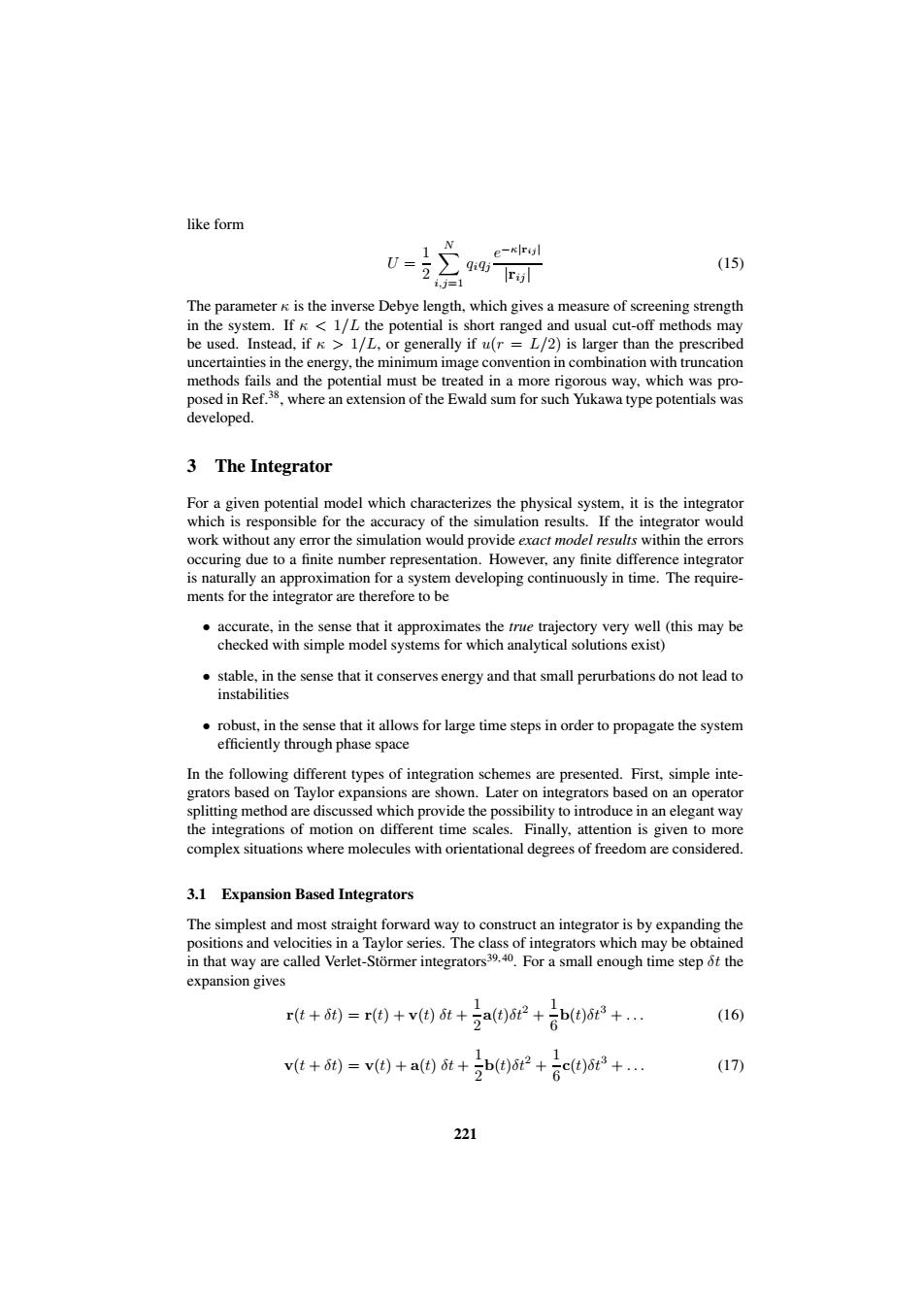正在加载图片...

like form 1 U= e-klrygl (15) i,j=1 The parameter k is the inverse Debye length,which gives a measure of screening strength in the system.If k<1/L the potential is short ranged and usual cut-off methods may be used.Instead,if 1/L,or generally if u(r =L/2)is larger than the prescribed uncertainties in the energy,the minimum image convention in combination with truncation methods fails and the potential must be treated in a more rigorous way,which was pro- posed in Ref.38,where an extension of the Ewald sum for such Yukawa type potentials was developed. 3 The Integrator For a given potential model which characterizes the physical system,it is the integrator which is responsible for the accuracy of the simulation results.If the integrator would work without any error the simulation would provide exact model results within the errors occuring due to a finite number representation.However,any finite difference integrator is naturally an approximation for a system developing continuously in time.The require- ments for the integrator are therefore to be .accurate,in the sense that it approximates the true trajectory very well (this may be checked with simple model systems for which analytical solutions exist) stable,in the sense that it conserves energy and that small perurbations do not lead to instabilities robust,in the sense that it allows for large time steps in order to propagate the system efficiently through phase space In the following different types of integration schemes are presented.First,simple inte- grators based on Taylor expansions are shown.Later on integrators based on an operator splitting method are discussed which provide the possibility to introduce in an elegant way the integrations of motion on different time scales.Finally,attention is given to more complex situations where molecules with orientational degrees of freedom are considered. 3.1 Expansion Based Integrators The simplest and most straight forward way to construct an integrator is by expanding the positions and velocities in a Taylor series.The class of integrators which may be obtained in that way are called Verlet-Stormer integrators39.40.For a small enough time step 6t the expansion gives rt+60)=r0+v因t+5a倒+b()63+.… (16) vt+0=v0+a0+b0r+ce0r+ (17) 221like form U = 1 2 X N i,j=1 qiqj e −κ|rij | |rij | (15) The parameter κ is the inverse Debye length, which gives a measure of screening strength in the system. If κ < 1/L the potential is short ranged and usual cut-off methods may be used. Instead, if κ > 1/L, or generally if u(r = L/2) is larger than the prescribed uncertainties in the energy, the minimum image convention in combination with truncation methods fails and the potential must be treated in a more rigorous way, which was proposed in Ref.38 , where an extension of the Ewald sum for such Yukawa type potentials was developed. 3 The Integrator For a given potential model which characterizes the physical system, it is the integrator which is responsible for the accuracy of the simulation results. If the integrator would work without any error the simulation would provide exact model results within the errors occuring due to a finite number representation. However, any finite difference integrator is naturally an approximation for a system developing continuously in time. The requirements for the integrator are therefore to be • accurate, in the sense that it approximates the true trajectory very well (this may be checked with simple model systems for which analytical solutions exist) • stable, in the sense that it conserves energy and that small perurbations do not lead to instabilities • robust, in the sense that it allows for large time steps in order to propagate the system efficiently through phase space In the following different types of integration schemes are presented. First, simple integrators based on Taylor expansions are shown. Later on integrators based on an operator splitting method are discussed which provide the possibility to introduce in an elegant way the integrations of motion on different time scales. Finally, attention is given to more complex situations where molecules with orientational degrees of freedom are considered. 3.1 Expansion Based Integrators The simplest and most straight forward way to construct an integrator is by expanding the positions and velocities in a Taylor series. The class of integrators which may be obtained in that way are called Verlet-Stormer ¨ integrators39, 40 . For a small enough time step δt the expansion gives r(t + δt) = r(t) + v(t) δt + 1 2 a(t)δt 2 + 1 6 b(t)δt 3 + . . . (16) v(t + δt) = v(t) + a(t) δt + 1 2 b(t)δt 2 + 1 6 c(t)δt 3 + . . . (17) 221